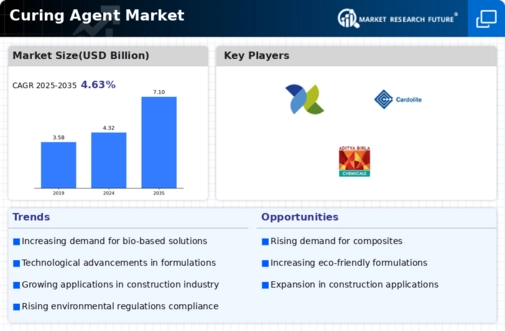Market Analysis
In-depth Analysis of Curing Agent Market Industry Landscape
Numerous dynamic elements impacting the market's growth and trends define the curing agent industry. Investigating the major factors that influence this market's behavior is essential to developing a thorough grasp of it. Here is a brief synopsis in the form of a paragraph using a pointer format: Changing End-Use Sectors: The changing demands of end-use industries have a big influence on the curing agent market dynamics. Curing agents are used by industries including composites, adhesives, and coatings to improve the strength and longevity of their products. The market dynamics are driven by the need for sophisticated curing agents with specialized features, such strong chemical resistance and short curing periods, as these sectors develop and innovate. Technological Developments in Formulations: Continuous innovation in formulation technologies is observed in the curing agent industry. Producers are creating curing agents with enhanced properties including less toxicity, lower emissions, and consistency with different substrates. These developments in technology tackle environmental issues and compliance needs, impacting end-user decisions and reshaping the market as a whole. Global Push for Sustainable Solutions: The curing agent market is seeing a change toward environmentally friendly and sustainable solutions as a result of the increased emphasis on sustainability on a worldwide scale. Environmentally friendly curing agents are becoming more and more common; they are frequently made from renewable or biobased basic ingredients. The prevailing patterns in the curing agent market are influenced by the rising inclination of consumers and industry towards goods with less environmental effect. High-Performance Coatings Are in Demand: The need for curing agents is mostly driven by the coatings sector. Industry demands for corrosion protection, chemical resistance, and aesthetic appeal in high-performance coatings have prompted the curing agent industry to develop specific formulas. The need for curing agents with particular qualities designed to overcome these problems is driven by the requirement for coatings that can survive extreme weather conditions. The State of Regulation and Adherence to Compliance Requirements: The market dynamics of curing agents are influenced by strict laws pertaining to emissions, volatile organic compounds (VOCs), and occupational safety. These restrictions, which manufacturers must follow, have prompted the creation of formulas. By establishing the allowed chemical compositions and use standards for curing agents, the regulatory landscape both shapes the market and serves as a driver for innovation.







Leave a Comment